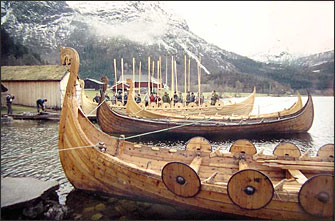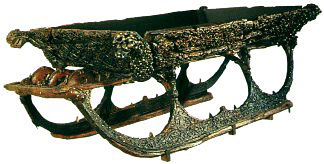EARLY MEDIEVAL ART
EARLY MEDIEVAL ART
- The early Medieval period was referred to as " the dark ages " as early as the 14 century by Petrarch (1304-1374) , an Italian poet and scholar of the fourteenth century, who found no redeeming qualities in civilizations after the loss of the Classical tradition in education and learning until the Renaissance.
VIKING ERA

Highly elaborate hilt of an early medieval Viking sword from Finland.
- The Viking Age lasted until the mid-11th century, when the Christianization of Scandinavia was largely completed. The period 1050 to 1350 ,when the Black Death struck Europe – is considered the Older Middle Ages. The period 1350 to 1523 , when king Gustav Vasa, who led the unification of Sweden, was crowned is considered the Younger Middle Ages.
- During this period, Sweden was gradually consolidated as a single nation. Scandinavia was formally Christianized by 1100 AD. The Kalmar Union between the Scandinavian countries was established in 1397 and lasted until Gustav Vasa ended it upon seizing power.

SEBERG STYLE This is the first Viking age style. The style has its name after the famous Viking ship burial at Oseberg in Norway.
- In fact, more than two million Arabian coins have been recovered in Viking burials all over Scandinavia, proving the extent of their exploring and trading.
- The Vikings traveled east to Russia and settled several places there, including the Baltic states of Estonia, Lithuania and Latvia. The name "Russia" actually originates from the Swedish (Rus = Vikings).

- Explorers often traveled to the Middle East trading silk, spices and jewelry with travelers from the Orient.
- The most common way of reaching these areas was through the big rivers of Europe, saving them weeks of effort sailing around the entire continent and through Gibraltar. They would sometimes pull their ships over dry land between the rivers.
- The Vikings also braved the open sea and sailed west to explore Iceland and Greenland. Historians have also proved that the Vikings were the first European settlers on the American continent.


- The Oseberg longship, from a Norwegian burial mound, dates from the 9th century. The elaborate burial was probably for a Norwegian queen.
- The ship is on display at the Viking Ship Museum in Oslo, Norway. On the right, one of three sledges that are part of the Oseberg burial site. In the winter, it was often easiest for the Vikings to travel overland, and sleighs like this were pulled by horses.
- The Viking explorers covered most of the known world during the Viking age. Viking settlers founded many large cities. Today, we find that Viking descendants all over Europe are proud of their heritage from these fierce and fearsome yet very culturally developed people from the North.


Comments
Post a Comment